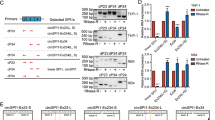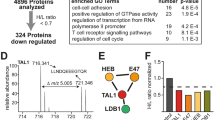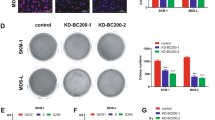Abstract
MicroRNAs (miRNAs) are crucial components of homeostatic and developmental gene regulation. In turn, dysregulation of miRNA expression is a common feature of different types of cancer, which can be harnessed therapeutically. Here we identify miR-139-5p suppression across several cytogenetically defined acute myeloid leukemia (AML) subgroups. The promoter of mir-139 was transcriptionally silenced and could be reactivated by histone deacetylase inhibitors in a dose-dependent manner. Restoration of mir-139 expression in cell lines representing the major AML subgroups (t[8;21], inv[16], mixed lineage leukemia-rearranged and complex karyotype AML) caused cell cycle arrest and apoptosis in vitro and in xenograft mouse models in vivo. During normal hematopoiesis, mir-139 is exclusively expressed in terminally differentiated neutrophils and macrophages. Ectopic expression of mir-139 repressed proliferation of normal CD34+-hematopoietic stem and progenitor cells and perturbed myelomonocytic in vitro differentiation. Mechanistically, mir-139 exerts its effects by repressing the translation initiation factor EIF4G2, thereby reducing overall protein synthesis while specifically inducing the translation of cell cycle inhibitor p27Kip1. Knockdown of EIF4G2 recapitulated the effects of mir-139, whereas restoring EIF4G2 expression rescued the mir-139 phenotype. Moreover, elevated miR-139-5p expression is associated with a favorable outcome in a cohort of 165 pediatric patients with AML. Thus, mir-139 acts as a global tumor suppressor-miR in AML by controlling protein translation. As AML cells are dependent on high protein synthesis rates controlling the expression of mir-139 constitutes a novel path for the treatment of AML.
This is a preview of subscription content, access via your institution
Access options
Subscribe to this journal
Receive 50 print issues and online access
$259.00 per year
only $5.18 per issue
Buy this article
- Purchase on Springer Link
- Instant access to full article PDF
Prices may be subject to local taxes which are calculated during checkout






Similar content being viewed by others
References
Sanders MA, Valk PJ . The evolving molecular genetic landscape in acute myeloid leukaemia. Curr Opin Hematol 2013; 20: 79–85.
Creutzig U, van den Heuvel-Eibrink MM, Gibson B, Dworzak MN, Adachi S, de Bont E et al. Diagnosis and management of acute myeloid leukemia in children and adolescents: recommendations from an international expert panel. Blood 2012, 10/18 120: 3187–3205.
Vardiman JW, Thiele J, Arber DA, Brunning RD, Borowitz MJ, Porwit A et al. The 2008 revision of the World Health Organization (WHO) classification of myeloid neoplasms and acute leukemia: rationale and important changes. Blood 2009; 114: 937–951.
Emmrich S, Katsman-Kuipers JE, Henke K, Khatib ME, Jammal R, Engeland F et al. miR-9 is a tumor suppressor in pediatric AML with t(8;21). Leukemia 2014; 28: 1022–1032.
Wang Z, Hong Z, Gao F, Feng W . Upregulation of microRNA-375 is associated with poor prognosis in pediatric acute myeloid leukemia. Mol Cell Biochem 2013; 383: 59–65.
Lee DW, Futami M, Carroll M, Feng Y, Wang Z, Fernandez M et al. Loss of SHIP-1 protein expression in high-risk myelodysplastic syndromes is associated with miR-210 and miR-155. Oncogene 2012; 31: 4085–4094.
Bartel DP . MicroRNAs: genomics, biogenesis, mechanism, and function. Cell 2004; 116: 281–297.
Berindan-Neagoe I, Monroig Pdel C, Pasculli B, Calin GA . MicroRNAome genome: a treasure for cancer diagnosis and therapy. CA Cancer J Clin 2014; 64: 311–336.
Klein U, Lia M, Crespo M, Siegel R, Shen Q, Mo T et al. The DLEU2/miR-15a/16-1 cluster controls B cell proliferation and its deletion leads to chronic lymphocytic leukemia. Cancer Cell 2010; 17: 28–40.
Wong CC, Wong CM, Tung EK, Au SL, Lee JM, Poon RT et al. The microRNA miR-139 suppresses metastasis and progression of hepatocellular carcinoma by down-regulating Rho-kinase 2. Gastroenterology 2011; 140: 322–331.
Li Z, Huang H, Li Y, Jiang X, Chen P, Arnovitz S et al. Up-regulation of a HOXA-PBX3 homeobox-gene signature following down-regulation of miR-181 is associated with adverse prognosis in patients with cytogenetically abnormal AML. Blood 2012; 119: 2314–2324.
Clemens MJ . Targets and mechanisms for the regulation of translation in malignant transformation. Oncogene 2004; 23: 3180–3188.
Lazaris-Karatzas A, Montine KS, Sonenberg N . Malignant transformation by a eukaryotic initiation factor subunit that binds to mRNA 5' cap. Nature 1990; 345: 544–547.
Hinnebusch AG, Lorsch JR . The mechanism of eukaryotic translation initiation: new insights and challenges. Cold Spring Harb Perspect Biol 2012; 4: doi:10.1101/cshperspect.a011544.
Avdulov S, Li S, Michalek V, Burrichter D, Peterson M, Perlman DM et al. Activation of translation complex eIF4F is essential for the genesis and maintenance of the malignant phenotype in human mammary epithelial cells. Cancer Cell 2004; 5: 553–563.
Fukuchi-Shimogori T, Ishii I, Kashiwagi K, Mashiba H, Ekimoto H, Igarashi K . Malignant transformation by overproduction of translation initiation factor eIF4G. Cancer Res 1997; 57: 5041–5044.
Hariri F, Arguello M, Volpon L, Culjkovic-Kraljacic B, Nielsen TH, Hiscott J et al. The eukaryotic translation initiation factor eIF4E is a direct transcriptional target of NF-kappaB and is aberrantly regulated in acute myeloid leukemia. Leukemia 2013; 27: 2047–2055.
Tamburini J, Green AS, Chapuis N, Bardet V, Lacombe C, Mayeux P et al. Targeting translation in acute myeloid leukemia: a new paradigm for therapy? Cell Cycle 2009; 8: 3893–3899.
Gradi A, Imataka H, Svitkin YV, Rom E, Raught B, Morino S et al. A novel functional human eukaryotic translation initiation factor 4G. Mol Cell Biol 1998; 18: 334–342.
Imataka H, Gradi A, Sonenberg N . A newly identified N-terminal amino acid sequence of human eIF4G binds poly(A)-binding protein and functions in poly(A)-dependent translation. EMBO J 1998; 17: 7480–7489.
Qin H, Raught B, Sonenberg N, Goldstein EG, Edelman AM . Phosphorylation screening identifies translational initiation factor 4GII as an intracellular target of Ca(2+)/calmodulin-dependent protein kinase I. J Biol Chem 2003; 278: 48570–48579.
Caron S, Charon M, Cramer E, Sonenberg N, Dusanter-Fourt I . Selective modification of eukaryotic initiation factor 4F (eIF4F) at the onset of cell differentiation: recruitment of eIF4GII and long-lasting phosphorylation of eIF4E. Mol Cell Biol 2004; 24: 4920–4928.
Tu L, Liu Z, He X, He Y, Yang H, Jiang Q et al. Over-expression of eukaryotic translation initiation factor 4gamma 1 correlates with tumor progression and poor prognosis in nasopharyngeal carcinoma. Mol Cancer 2010; 9: 78 4598-9-78.
Solh M, Yohe S, Weisdorf D, Ustun C . Core-binding factor acute myeloid leukemia: Heterogeneity, monitoring, and therapy. Am J Hematol 2014; 89: 1121–1131.
Weber K, Bartsch U, Stocking C, Fehse B . A multicolor panel of novel lentiviral "gene ontology" (LeGO) vectors for functional gene analysis. Mol Ther 2008; 16: 698–706.
Cheng J, Guo S, Chen S, Mastriano SJ, Liu C, D'Alessio AC et al. An extensive network of TET2-targeting MicroRNAs regulates malignant hematopoiesis. Cell Rep 2013; 5: 471–481.
Masaki S, Ohtsuka R, Abe Y, Muta K, Umemura T . Expression patterns of microRNAs 155 and 451 during normal human erythropoiesis. Biochem Biophys Res Commun 2007; 364: 509–514.
Shen K, Mao R, Ma L, Li Y, Qiu Y, Cui D et al. Post-transcriptional regulation of the tumor suppressor miR-139-5p and a network of miR-139-5p-mediated mRNA interactions in colorectal cancer. FEBS J 2014; 281: 3609–3624.
Bao W, Fu HJ, Xie QS, Wang L, Zhang R, Guo ZY et al. HER2 interacts with CD44 to up-regulate CXCR4 via epigenetic silencing of microRNA-139 in gastric cancer cells. Gastroenterology 2011; 141: 2076–2087.e6.
Vinther J, Hedegaard MM, Gardner PP, Andersen JS, Arctander P . Identification of miRNA targets with stable isotope labeling by amino acids in cell culture. Nucleic Acids Res 2006; 34: e107.
Boussemart L, Malka-Mahieu H, Girault I, Allard D, Hemmingsson O, Tomasic G et al. eIF4F is a nexus of resistance to anti-BRAF and anti-MEK cancer therapies. Nature 2014; 513: 105–109.
Kar AN, MacGibeny MA, Gervasi NM, Gioio AE, Kaplan BB . Intra-axonal synthesis of eukaryotic translation initiation factors regulates local protein synthesis and axon growth in rat sympathetic neurons. J Neurosci 2013; 33: 7165–7174.
Breinbauer R, Kohn M . Azide-alkyne coupling: a powerful reaction for bioconjugate chemistry. Chembiochem 2003; 4: 1147–1149.
Yanagisawa K, Horiuchi T, Fujita S . Establishment and characterization of a new human leukemia cell line derived from M4E0. Blood 1991; 78: 451–457.
Lee SH, McCormick F . p97/DAP5 is a ribosome-associated factor that facilitates protein synthesis and cell proliferation by modulating the synthesis of cell cycle proteins. EMBO J 2006; 25: 4008–4019.
Chen P, Price C, Li Z, Li Y, Cao D, Wiley A et al. miR-9 is an essential oncogenic microRNA specifically overexpressed in mixed lineage leukemia-rearranged leukemia. Proc Natl Acad Sci USA 2013; 110: 11511–11516.
Dou L, Zheng D, Li J, Li Y, Gao L, Wang L et al. Methylation-mediated repression of microRNA-143 enhances MLL-AF4 oncogene expression. Oncogene 2012; 31: 507–517.
Luo HN, Wang ZH, Sheng Y, Zhang Q, Yan J, Hou J et al. MiR-139 targets CXCR4 and inhibits the proliferation and metastasis of laryngeal squamous carcinoma cells. Med Oncol 2014; 31: 789 ..
Krishnan K, Steptoe AL, Martin HC, Pattabiraman DR, Nones K, Waddell N et al. miR-139-5p is a regulator of metastatic pathways in breast cancer. RNA 2013; 19: 1767–1780.
Fan Q, He M, Deng X, Wu WK, Zhao L, Tang J et al. Derepression of c-Fos caused by microRNA-139 down-regulation contributes to the metastasis of human hepatocellular carcinoma. Cell Biochem Funct 2013; 31: 319–324.
Gu W, Li X, Wang J . miR-139 regulates the proliferation and invasion of hepatocellular carcinoma through the WNT/TCF-4 pathway. Oncol Rep 2014; 31: 397–404.
Li RY, Chen LC, Zhang HY, Du WZ, Feng Y, Wang HB et al. MiR-139 inhibits Mcl-1 expression and potentiates TMZ-induced apoptosis in glioma. CNS Neurosci Ther 2013; 19: 477–483.
Zhang L, Dong Y, Zhu N, Tsoi H, Zhao Z, Wu CW et al. microRNA-139-5p exerts tumor suppressor function by targeting NOTCH1 in colorectal cancer. Mol Cancer 2014; 13: 124–4598-13-124.
Henis-Korenblit S, Shani G, Sines T, Marash L, Shohat G, Kimchi A . The caspase-cleaved DAP5 protein supports internal ribosome entry site-mediated translation of death proteins. Proc Natl Acad Sci USA 2002; 99: 5400–5405.
Nousch M, Reed V, Bryson-Richardson RJ, Currie PD, Preiss T . The eIF4G-homolog p97 can activate translation independent of caspase cleavage. RNA 2007; 13: 374–384.
Mazan-Mamczarz K, Zhao XF, Dai B, Steinhardt JJ, Peroutka RJ, Berk KL et al. Down-regulation of eIF4GII by miR-520c-3p represses diffuse large B cell lymphoma development. PLoS Genet 2014; 10: e1004105.
Srivastava T, Fortin DA, Nygaard S, Kaech S, Sonenberg N, Edelman AM et al. Regulation of neuronal mRNA translation by CaM-kinase I phosphorylation of eIF4GII. J Neurosci 2012; 32: 5620–5630.
Virgili G, Frank F, Feoktistova K, Sawicki M, Sonenberg N, Fraser CS et al. Structural analysis of the DAP5 MIF4G domain and its interaction with eIF4A. Structure 2013; 21: 517–527.
Marash L, Liberman N, Henis-Korenblit S, Sivan G, Reem E, Elroy-Stein O et al. DAP5 promotes cap-independent translation of Bcl-2 and CDK1 to facilitate cell survival during mitosis. Mol Cell 2008; 30: 447–459.
Martelli AM, Nyakern M, Tabellini G, Bortul R, Tazzari PL, Evangelisti C et al. Phosphoinositide 3-kinase/Akt signaling pathway and its therapeutical implications for human acute myeloid leukemia. Leukemia 2006; 20: 911–928.
Holcik M, Sonenberg N . Translational control in stress and apoptosis. Nat Rev Mol Cell Biol 2005; 6: 318–327.
Alemdehy MF, Haanstra JR, de Looper HW, van Strien PM, Verhagen-Oldenampsen J, Caljouw Y et al. Interstrand cross-link induced miR139-3p and miR199a-3p have opposite roles in hematopoietic cell expansion and leukemic transformation. Blood 2015.
Jiang H, Shukla A, Wang X, Chen WY, Bernstein BE, Roeder RG . Role for Dpy-30 in ES cell-fate specification by regulation of H3K4 methylation within bivalent domains. Cell 2011; 144: 513–525.
Cheng YC, Lin TY, Shieh SY . Candidate tumor suppressor BTG3 maintains genomic stability by promoting Lys63-linked ubiquitination and activation of the checkpoint kinase CHK1. Proc Natl Acad Sci USA 2013; 110: 5993–5998.
Yu J, Zhang Y, Qi Z, Kurtycz D, Vacano G, Patterson D . Methylation-mediated downregulation of the B-cell translocation gene 3 (BTG3) in breast cancer cells. Gene Expr 2008; 14: 173–182.
Deng B, Zhao Y, Gou W, Chen S, Mao X, Takano Y et al. Decreased expression of BTG3 was linked to carcinogenesis, aggressiveness, and prognosis of ovarian carcinoma. Tumour Biol 2013; 34: 2617–2624.
Lin TY, Cheng YC, Yang HC, Lin WC, Wang CC, Lai PL et al. Loss of the candidate tumor suppressor BTG3 triggers acute cellular senescence via the ERK-JMJD3-p16(INK4a) signaling axis. Oncogene 2012; 31: 3287–3297.
Scheicher R, Hoelbl-Kovacic A, Bellutti F, Tigan AS, Prchal-Murphy M, Heller G et al. CDK6 as a key regulator of hematopoietic and leukemic stem cell activation. Blood 2014; 125: 90–101.
Placke T, Faber K, Nonami A, Putwain SL, Salih HR, Heidel FH et al. Requirement for CDK6 in MLL-rearranged acute myeloid leukemia. Blood 2014; 124: 13–23.
Stankov MV, El Khatib M, Kumar TB, Heitmann K, Panayotova-Dimitrova D, Schoening J et al. Histone deacetylase inhibitors induce apoptosis in myeloid leukemia by suppressing autophagy. Leukemia 2014 03; 28: 577–588.
Acknowledgements
The authors thank Drs K Weber, B Fehse and D Heckl for providing plasmids; Dr M Ballmaier for sorting. SE, FE and KH were supported by the Hannover Biomedical Research School. JEK-K was supported by the Children Cancer Free Foundation (KIKA, project 49). JHK is a fellow of the Emmy Noether-Programme from the German Research Foundation (DFG; KL-2374/2-1). A.O. was supported by KIKA project 109. This work was supported by grants to CMZ and MMvdH-E from the Children Cancer Free Foundation (KIKA, projects 49 and 109) and to JHK from the DFG (KL-2374/2-1).
Author information
Authors and Affiliations
Corresponding author
Ethics declarations
Competing interests
The authors declare no conflict of interest.
Additional information
Supplementary Information accompanies this paper on the Oncogene website
Supplementary information
Rights and permissions
About this article
Cite this article
Emmrich, S., Engeland, F., El-Khatib, M. et al. miR-139-5p controls translation in myeloid leukemia through EIF4G2. Oncogene 35, 1822–1831 (2016). https://doi.org/10.1038/onc.2015.247
Received:
Revised:
Accepted:
Published:
Issue Date:
DOI: https://doi.org/10.1038/onc.2015.247
This article is cited by
-
MicroRNA-877-5p promotes osteoblast differentiation by targeting EIF4G2 expression
Journal of Orthopaedic Surgery and Research (2024)
-
Insight into microRNAs’ involvement in hematopoiesis: current standing point of findings
Stem Cell Research & Therapy (2023)
-
Tackling FGFR3-driven bladder cancer with a promising synergistic FGFR/HDAC targeted therapy
npj Precision Oncology (2023)
-
The tumor suppressor MIR139 is silenced by POLR2M to promote AML oncogenesis
Leukemia (2022)
-
MiR-144-3p-mediated dysregulation of EIF4G2 contributes to the development of hepatocellular carcinoma through the ERK pathway
Journal of Experimental & Clinical Cancer Research (2021)



